Analyzing Sustainable Development in Infrastructure Projects
VerifiedAdded on 2020/05/28
|20
|4374
|181
AI Summary
The assignment requires an evaluation of the role and effectiveness of public-private partnerships (PPPs) in construction projects. Students will analyze how these collaborations can enhance project delivery, promote sustainability, and manage stakeholder relationships effectively. The analysis should draw from various sources to assess the benefits and challenges associated with PPPs in construction management.

Student’s Name:
Institutional Affiliation:
Institutional Affiliation:
Paraphrase This Document
Need a fresh take? Get an instant paraphrase of this document with our AI Paraphraser
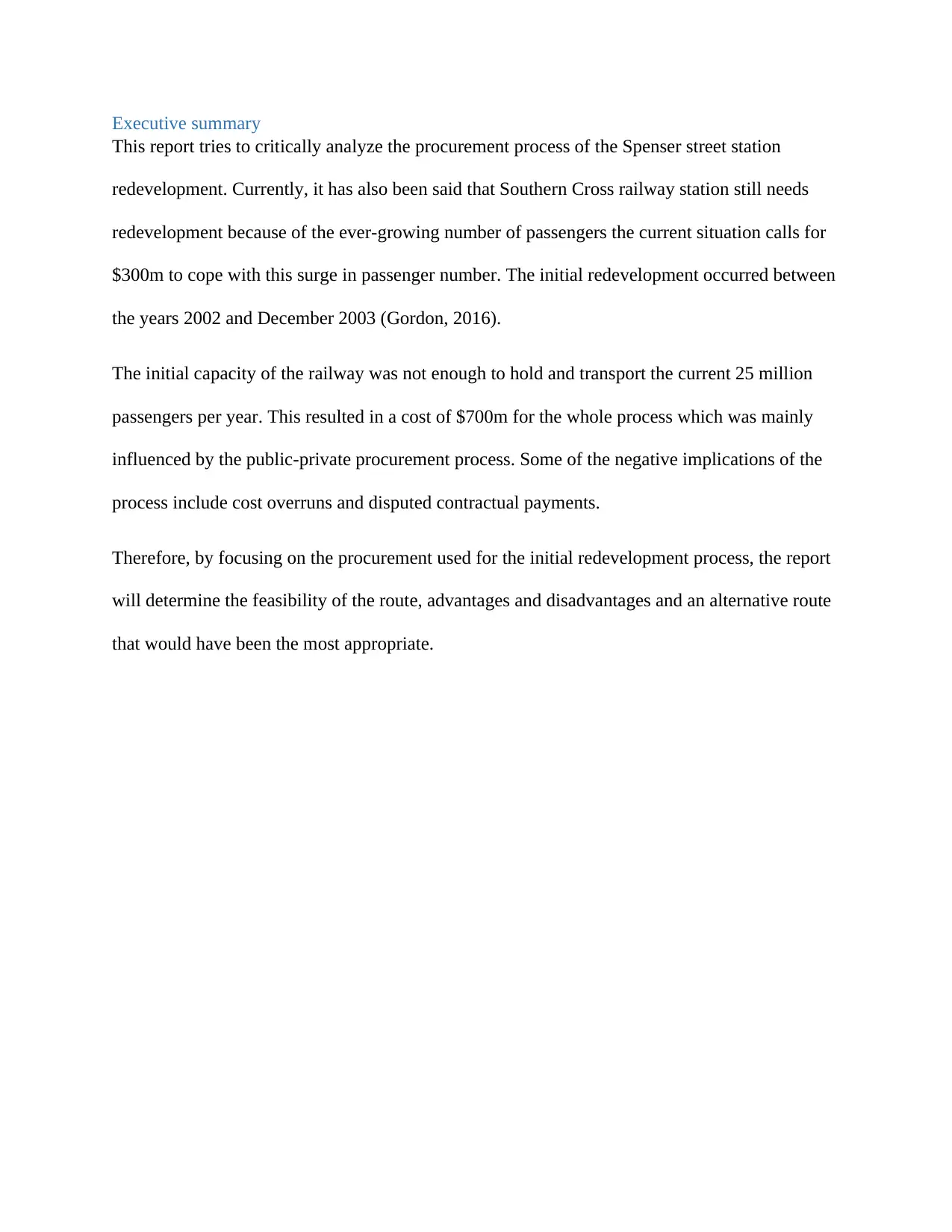
Executive summary
This report tries to critically analyze the procurement process of the Spenser street station
redevelopment. Currently, it has also been said that Southern Cross railway station still needs
redevelopment because of the ever-growing number of passengers the current situation calls for
$300m to cope with this surge in passenger number. The initial redevelopment occurred between
the years 2002 and December 2003 (Gordon, 2016).
The initial capacity of the railway was not enough to hold and transport the current 25 million
passengers per year. This resulted in a cost of $700m for the whole process which was mainly
influenced by the public-private procurement process. Some of the negative implications of the
process include cost overruns and disputed contractual payments.
Therefore, by focusing on the procurement used for the initial redevelopment process, the report
will determine the feasibility of the route, advantages and disadvantages and an alternative route
that would have been the most appropriate.
This report tries to critically analyze the procurement process of the Spenser street station
redevelopment. Currently, it has also been said that Southern Cross railway station still needs
redevelopment because of the ever-growing number of passengers the current situation calls for
$300m to cope with this surge in passenger number. The initial redevelopment occurred between
the years 2002 and December 2003 (Gordon, 2016).
The initial capacity of the railway was not enough to hold and transport the current 25 million
passengers per year. This resulted in a cost of $700m for the whole process which was mainly
influenced by the public-private procurement process. Some of the negative implications of the
process include cost overruns and disputed contractual payments.
Therefore, by focusing on the procurement used for the initial redevelopment process, the report
will determine the feasibility of the route, advantages and disadvantages and an alternative route
that would have been the most appropriate.
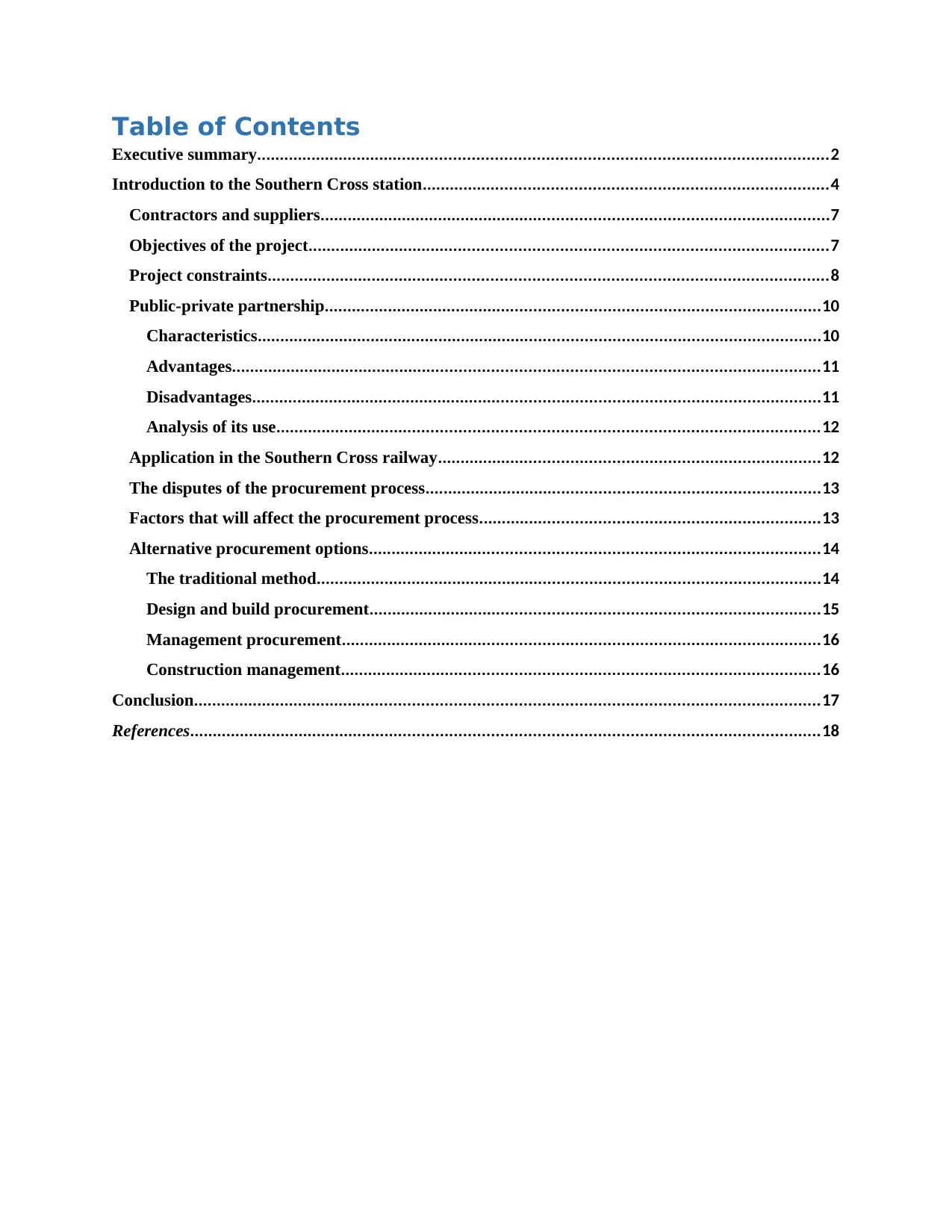
Table of Contents
Executive summary............................................................................................................................2
Introduction to the Southern Cross station........................................................................................4
Contractors and suppliers...............................................................................................................7
Objectives of the project.................................................................................................................7
Project constraints..........................................................................................................................8
Public-private partnership............................................................................................................10
Characteristics...........................................................................................................................10
Advantages................................................................................................................................11
Disadvantages............................................................................................................................11
Analysis of its use......................................................................................................................12
Application in the Southern Cross railway...................................................................................12
The disputes of the procurement process......................................................................................13
Factors that will affect the procurement process..........................................................................13
Alternative procurement options..................................................................................................14
The traditional method..............................................................................................................14
Design and build procurement..................................................................................................15
Management procurement........................................................................................................16
Construction management........................................................................................................16
Conclusion........................................................................................................................................17
References.........................................................................................................................................18
Executive summary............................................................................................................................2
Introduction to the Southern Cross station........................................................................................4
Contractors and suppliers...............................................................................................................7
Objectives of the project.................................................................................................................7
Project constraints..........................................................................................................................8
Public-private partnership............................................................................................................10
Characteristics...........................................................................................................................10
Advantages................................................................................................................................11
Disadvantages............................................................................................................................11
Analysis of its use......................................................................................................................12
Application in the Southern Cross railway...................................................................................12
The disputes of the procurement process......................................................................................13
Factors that will affect the procurement process..........................................................................13
Alternative procurement options..................................................................................................14
The traditional method..............................................................................................................14
Design and build procurement..................................................................................................15
Management procurement........................................................................................................16
Construction management........................................................................................................16
Conclusion........................................................................................................................................17
References.........................................................................................................................................18
⊘ This is a preview!⊘
Do you want full access?
Subscribe today to unlock all pages.

Trusted by 1+ million students worldwide
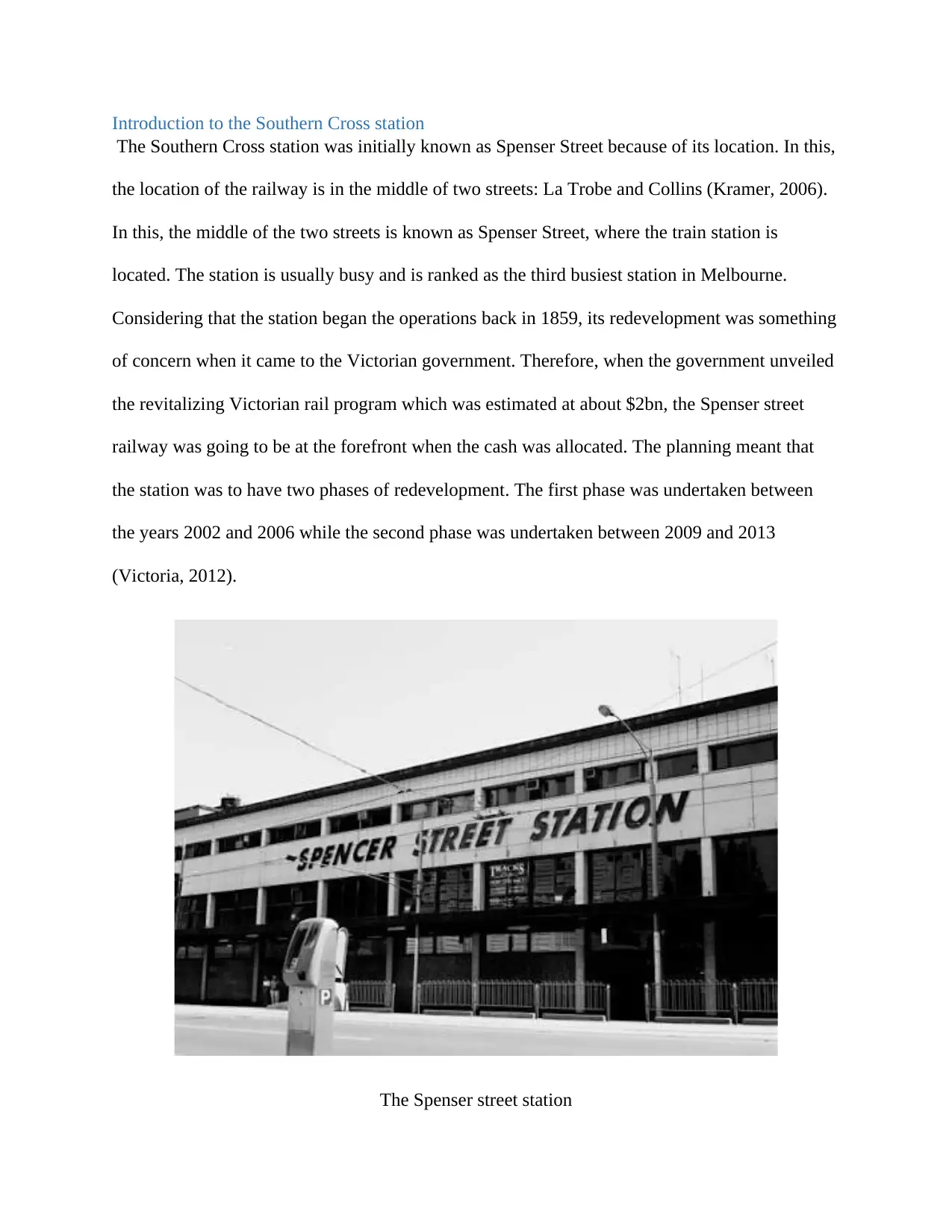
Introduction to the Southern Cross station
The Southern Cross station was initially known as Spenser Street because of its location. In this,
the location of the railway is in the middle of two streets: La Trobe and Collins (Kramer, 2006).
In this, the middle of the two streets is known as Spenser Street, where the train station is
located. The station is usually busy and is ranked as the third busiest station in Melbourne.
Considering that the station began the operations back in 1859, its redevelopment was something
of concern when it came to the Victorian government. Therefore, when the government unveiled
the revitalizing Victorian rail program which was estimated at about $2bn, the Spenser street
railway was going to be at the forefront when the cash was allocated. The planning meant that
the station was to have two phases of redevelopment. The first phase was undertaken between
the years 2002 and 2006 while the second phase was undertaken between 2009 and 2013
(Victoria, 2012).
The Spenser street station
The Southern Cross station was initially known as Spenser Street because of its location. In this,
the location of the railway is in the middle of two streets: La Trobe and Collins (Kramer, 2006).
In this, the middle of the two streets is known as Spenser Street, where the train station is
located. The station is usually busy and is ranked as the third busiest station in Melbourne.
Considering that the station began the operations back in 1859, its redevelopment was something
of concern when it came to the Victorian government. Therefore, when the government unveiled
the revitalizing Victorian rail program which was estimated at about $2bn, the Spenser street
railway was going to be at the forefront when the cash was allocated. The planning meant that
the station was to have two phases of redevelopment. The first phase was undertaken between
the years 2002 and 2006 while the second phase was undertaken between 2009 and 2013
(Victoria, 2012).
The Spenser street station
Paraphrase This Document
Need a fresh take? Get an instant paraphrase of this document with our AI Paraphraser

Aerial view
Initially, the station had a single platform but the need for more platforms became more evident
with the increasing need and demand for the railway transport. This led to the development of 13
platforms in the first phase while the second phase saw two more platforms added to the station.
Currently, the station has 16 platforms (Victoria, 2012).
In the year 2002, some of the major considerations included: provision of an interchange facility
that would ensure that both buses and trains used the station, the provision of a new entrance,
provision of a residential tower, an office tower, increase of the parking space, a shopping
complex at the center of La Trobe and Bourke streets, a new bridge at the passenger side among
others. All these developments were to ensure that the station could handle the increasing
passenger numbers but this is yet to be fulfilled.
Initially, the station had a single platform but the need for more platforms became more evident
with the increasing need and demand for the railway transport. This led to the development of 13
platforms in the first phase while the second phase saw two more platforms added to the station.
Currently, the station has 16 platforms (Victoria, 2012).
In the year 2002, some of the major considerations included: provision of an interchange facility
that would ensure that both buses and trains used the station, the provision of a new entrance,
provision of a residential tower, an office tower, increase of the parking space, a shopping
complex at the center of La Trobe and Bourke streets, a new bridge at the passenger side among
others. All these developments were to ensure that the station could handle the increasing
passenger numbers but this is yet to be fulfilled.

One major feature of the Southern Cross station is the architectural design of the roofing system
employed. The station has gone full lengths to ensure that the pattern of the roof is so unique to
the extent that it won the Lubetkin prize among other awards. The design of the roof serves both
aesthetic functions as well as for air ventilation (Hardie, et al., 2012).The air at the station is
filled with toxic diesel fumes and by ensuring that the roof is undulating and trapezoidal in
shape, the fumes are expelled through ducts located on the highest points (Butland, 2002). The
roofing is so tremendous that it spans over an area of about 60000 square meters and can go as
high as 23 meters (Wilson, et al., 2010).
Redeveloped station
employed. The station has gone full lengths to ensure that the pattern of the roof is so unique to
the extent that it won the Lubetkin prize among other awards. The design of the roof serves both
aesthetic functions as well as for air ventilation (Hardie, et al., 2012).The air at the station is
filled with toxic diesel fumes and by ensuring that the roof is undulating and trapezoidal in
shape, the fumes are expelled through ducts located on the highest points (Butland, 2002). The
roofing is so tremendous that it spans over an area of about 60000 square meters and can go as
high as 23 meters (Wilson, et al., 2010).
Redeveloped station
⊘ This is a preview!⊘
Do you want full access?
Subscribe today to unlock all pages.

Trusted by 1+ million students worldwide

Contractors and suppliers
All that stated, the project was conducted through combined efforts of various contractors,
partners, and other agencies. The two main contractors of the redevelopment project are Civic
Nexus and Leighton contractors (Cuthill, 2010). The other companies involved in the contractual
work included Delaware north Australia and ABN Amro among others. On the other hand, the
sound environmental practices of sustainable development (Eskerod & Huemann, 2013) were
mainly conducted by build Ecology and Vision design. The brand is a specialist branch of WSP
Lincolne Scott and provided the sound and environmental designs of the project. Last but not
least is Alfasi Steel construction. The redevelopment consumed a humongous chunk of steel
which was provided by the aforementioned.
Objectives of the project
The redevelopment of the Spenser street station may largely be attributed to the increased
number of passenger. However, other factors may have contributed to this $700m project that
has helped ensure that the travel options in Victoria are numerous. However, the redevelopment
is yet to meet the number of pedestrians expected with a redevelopment plan that will cost the
government $300m more still expected. The growth of the station is so remarkable that it is on s
straight trajectory and if the development plans are successful, it could become one of the busiest
transport hubs in the state, rivaling Melbourne airport (Australian Bureau of Statistics, 2012).
The roofing system was to be designed in such a way that it provided a proper ventilation
mechanism while it still remained attractive and pleasing to the public. This was done by
providing a trapezoidal roof with a wavering facade and a ventilation system at the top (The
leadership in Energy and environmental design, 2007).
Finally, the project was focused on the management and coordination of commuters at the
station. The program focused on the stakeholders as well as the community (Victoria building
All that stated, the project was conducted through combined efforts of various contractors,
partners, and other agencies. The two main contractors of the redevelopment project are Civic
Nexus and Leighton contractors (Cuthill, 2010). The other companies involved in the contractual
work included Delaware north Australia and ABN Amro among others. On the other hand, the
sound environmental practices of sustainable development (Eskerod & Huemann, 2013) were
mainly conducted by build Ecology and Vision design. The brand is a specialist branch of WSP
Lincolne Scott and provided the sound and environmental designs of the project. Last but not
least is Alfasi Steel construction. The redevelopment consumed a humongous chunk of steel
which was provided by the aforementioned.
Objectives of the project
The redevelopment of the Spenser street station may largely be attributed to the increased
number of passenger. However, other factors may have contributed to this $700m project that
has helped ensure that the travel options in Victoria are numerous. However, the redevelopment
is yet to meet the number of pedestrians expected with a redevelopment plan that will cost the
government $300m more still expected. The growth of the station is so remarkable that it is on s
straight trajectory and if the development plans are successful, it could become one of the busiest
transport hubs in the state, rivaling Melbourne airport (Australian Bureau of Statistics, 2012).
The roofing system was to be designed in such a way that it provided a proper ventilation
mechanism while it still remained attractive and pleasing to the public. This was done by
providing a trapezoidal roof with a wavering facade and a ventilation system at the top (The
leadership in Energy and environmental design, 2007).
Finally, the project was focused on the management and coordination of commuters at the
station. The program focused on the stakeholders as well as the community (Victoria building
Paraphrase This Document
Need a fresh take? Get an instant paraphrase of this document with our AI Paraphraser
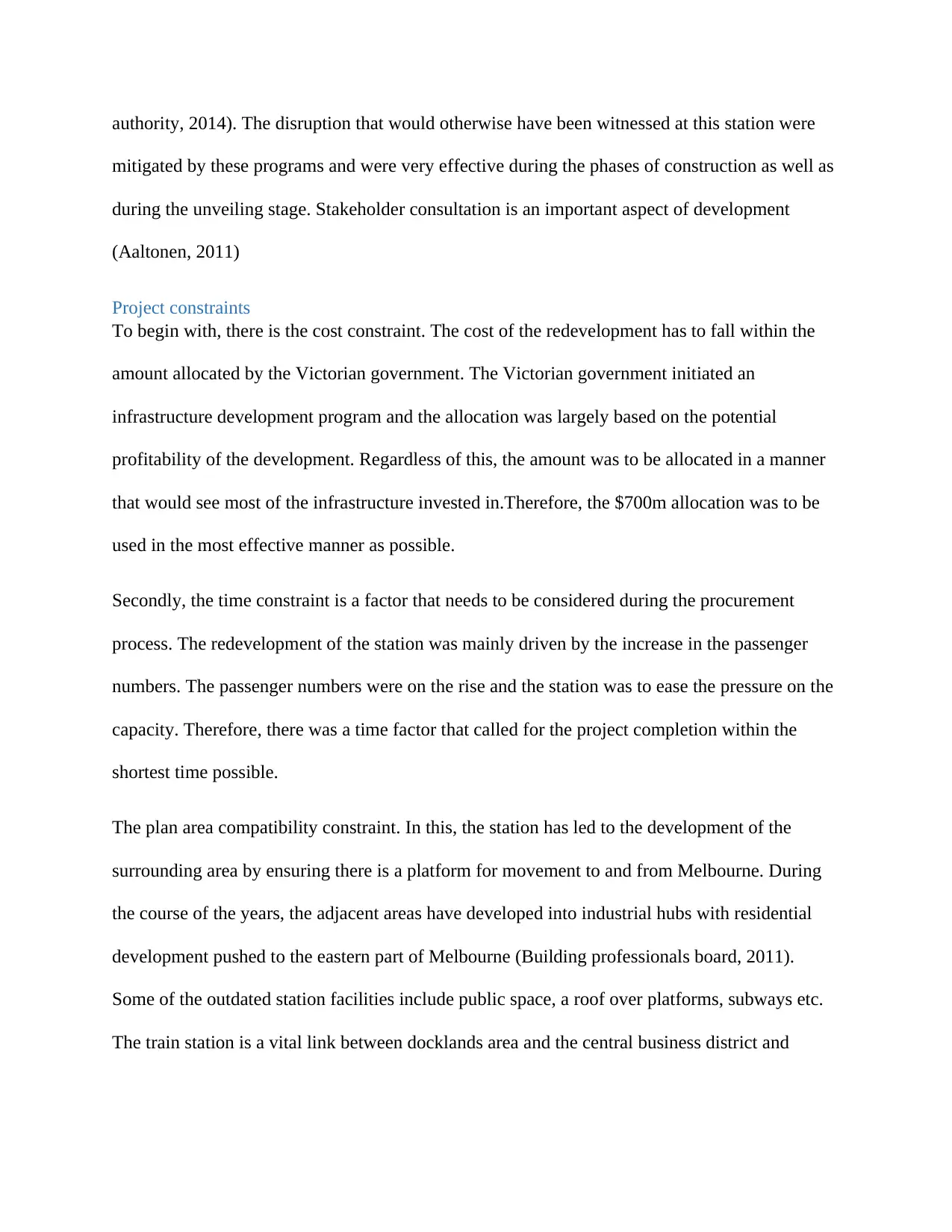
authority, 2014). The disruption that would otherwise have been witnessed at this station were
mitigated by these programs and were very effective during the phases of construction as well as
during the unveiling stage. Stakeholder consultation is an important aspect of development
(Aaltonen, 2011)
Project constraints
To begin with, there is the cost constraint. The cost of the redevelopment has to fall within the
amount allocated by the Victorian government. The Victorian government initiated an
infrastructure development program and the allocation was largely based on the potential
profitability of the development. Regardless of this, the amount was to be allocated in a manner
that would see most of the infrastructure invested in.Therefore, the $700m allocation was to be
used in the most effective manner as possible.
Secondly, the time constraint is a factor that needs to be considered during the procurement
process. The redevelopment of the station was mainly driven by the increase in the passenger
numbers. The passenger numbers were on the rise and the station was to ease the pressure on the
capacity. Therefore, there was a time factor that called for the project completion within the
shortest time possible.
The plan area compatibility constraint. In this, the station has led to the development of the
surrounding area by ensuring there is a platform for movement to and from Melbourne. During
the course of the years, the adjacent areas have developed into industrial hubs with residential
development pushed to the eastern part of Melbourne (Building professionals board, 2011).
Some of the outdated station facilities include public space, a roof over platforms, subways etc.
The train station is a vital link between docklands area and the central business district and
mitigated by these programs and were very effective during the phases of construction as well as
during the unveiling stage. Stakeholder consultation is an important aspect of development
(Aaltonen, 2011)
Project constraints
To begin with, there is the cost constraint. The cost of the redevelopment has to fall within the
amount allocated by the Victorian government. The Victorian government initiated an
infrastructure development program and the allocation was largely based on the potential
profitability of the development. Regardless of this, the amount was to be allocated in a manner
that would see most of the infrastructure invested in.Therefore, the $700m allocation was to be
used in the most effective manner as possible.
Secondly, the time constraint is a factor that needs to be considered during the procurement
process. The redevelopment of the station was mainly driven by the increase in the passenger
numbers. The passenger numbers were on the rise and the station was to ease the pressure on the
capacity. Therefore, there was a time factor that called for the project completion within the
shortest time possible.
The plan area compatibility constraint. In this, the station has led to the development of the
surrounding area by ensuring there is a platform for movement to and from Melbourne. During
the course of the years, the adjacent areas have developed into industrial hubs with residential
development pushed to the eastern part of Melbourne (Building professionals board, 2011).
Some of the outdated station facilities include public space, a roof over platforms, subways etc.
The train station is a vital link between docklands area and the central business district and
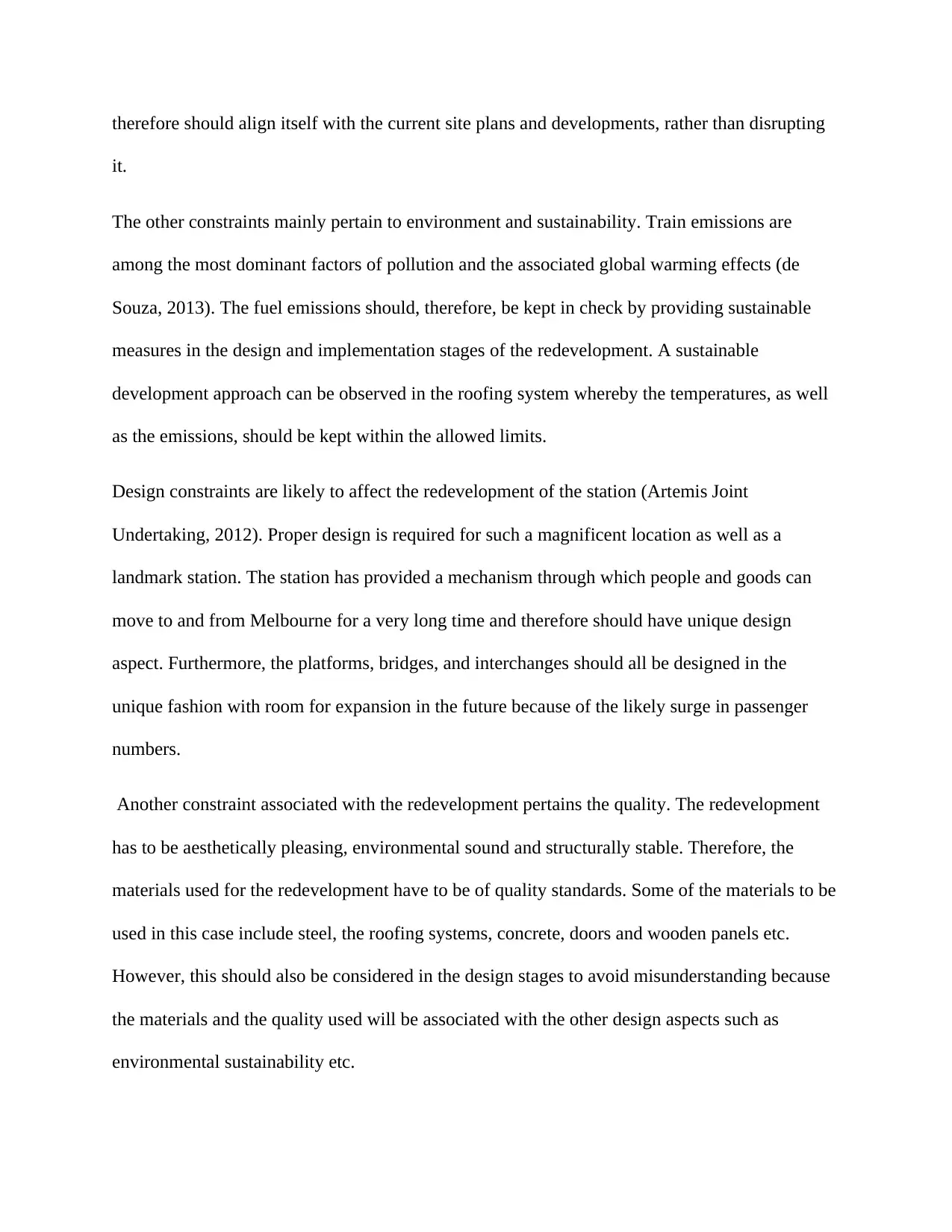
therefore should align itself with the current site plans and developments, rather than disrupting
it.
The other constraints mainly pertain to environment and sustainability. Train emissions are
among the most dominant factors of pollution and the associated global warming effects (de
Souza, 2013). The fuel emissions should, therefore, be kept in check by providing sustainable
measures in the design and implementation stages of the redevelopment. A sustainable
development approach can be observed in the roofing system whereby the temperatures, as well
as the emissions, should be kept within the allowed limits.
Design constraints are likely to affect the redevelopment of the station (Artemis Joint
Undertaking, 2012). Proper design is required for such a magnificent location as well as a
landmark station. The station has provided a mechanism through which people and goods can
move to and from Melbourne for a very long time and therefore should have unique design
aspect. Furthermore, the platforms, bridges, and interchanges should all be designed in the
unique fashion with room for expansion in the future because of the likely surge in passenger
numbers.
Another constraint associated with the redevelopment pertains the quality. The redevelopment
has to be aesthetically pleasing, environmental sound and structurally stable. Therefore, the
materials used for the redevelopment have to be of quality standards. Some of the materials to be
used in this case include steel, the roofing systems, concrete, doors and wooden panels etc.
However, this should also be considered in the design stages to avoid misunderstanding because
the materials and the quality used will be associated with the other design aspects such as
environmental sustainability etc.
it.
The other constraints mainly pertain to environment and sustainability. Train emissions are
among the most dominant factors of pollution and the associated global warming effects (de
Souza, 2013). The fuel emissions should, therefore, be kept in check by providing sustainable
measures in the design and implementation stages of the redevelopment. A sustainable
development approach can be observed in the roofing system whereby the temperatures, as well
as the emissions, should be kept within the allowed limits.
Design constraints are likely to affect the redevelopment of the station (Artemis Joint
Undertaking, 2012). Proper design is required for such a magnificent location as well as a
landmark station. The station has provided a mechanism through which people and goods can
move to and from Melbourne for a very long time and therefore should have unique design
aspect. Furthermore, the platforms, bridges, and interchanges should all be designed in the
unique fashion with room for expansion in the future because of the likely surge in passenger
numbers.
Another constraint associated with the redevelopment pertains the quality. The redevelopment
has to be aesthetically pleasing, environmental sound and structurally stable. Therefore, the
materials used for the redevelopment have to be of quality standards. Some of the materials to be
used in this case include steel, the roofing systems, concrete, doors and wooden panels etc.
However, this should also be considered in the design stages to avoid misunderstanding because
the materials and the quality used will be associated with the other design aspects such as
environmental sustainability etc.
⊘ This is a preview!⊘
Do you want full access?
Subscribe today to unlock all pages.

Trusted by 1+ million students worldwide
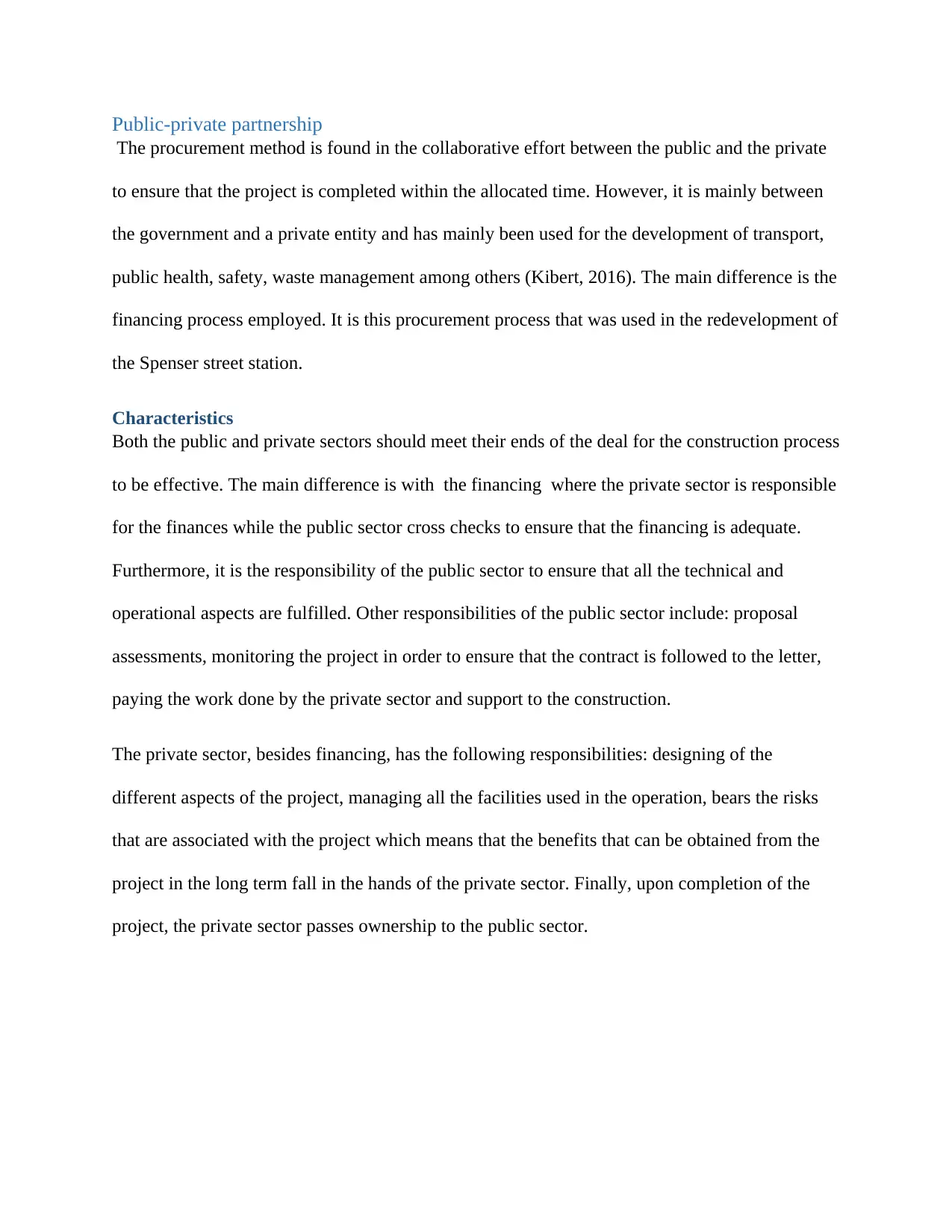
Public-private partnership
The procurement method is found in the collaborative effort between the public and the private
to ensure that the project is completed within the allocated time. However, it is mainly between
the government and a private entity and has mainly been used for the development of transport,
public health, safety, waste management among others (Kibert, 2016). The main difference is the
financing process employed. It is this procurement process that was used in the redevelopment of
the Spenser street station.
Characteristics
Both the public and private sectors should meet their ends of the deal for the construction process
to be effective. The main difference is with the financing where the private sector is responsible
for the finances while the public sector cross checks to ensure that the financing is adequate.
Furthermore, it is the responsibility of the public sector to ensure that all the technical and
operational aspects are fulfilled. Other responsibilities of the public sector include: proposal
assessments, monitoring the project in order to ensure that the contract is followed to the letter,
paying the work done by the private sector and support to the construction.
The private sector, besides financing, has the following responsibilities: designing of the
different aspects of the project, managing all the facilities used in the operation, bears the risks
that are associated with the project which means that the benefits that can be obtained from the
project in the long term fall in the hands of the private sector. Finally, upon completion of the
project, the private sector passes ownership to the public sector.
The procurement method is found in the collaborative effort between the public and the private
to ensure that the project is completed within the allocated time. However, it is mainly between
the government and a private entity and has mainly been used for the development of transport,
public health, safety, waste management among others (Kibert, 2016). The main difference is the
financing process employed. It is this procurement process that was used in the redevelopment of
the Spenser street station.
Characteristics
Both the public and private sectors should meet their ends of the deal for the construction process
to be effective. The main difference is with the financing where the private sector is responsible
for the finances while the public sector cross checks to ensure that the financing is adequate.
Furthermore, it is the responsibility of the public sector to ensure that all the technical and
operational aspects are fulfilled. Other responsibilities of the public sector include: proposal
assessments, monitoring the project in order to ensure that the contract is followed to the letter,
paying the work done by the private sector and support to the construction.
The private sector, besides financing, has the following responsibilities: designing of the
different aspects of the project, managing all the facilities used in the operation, bears the risks
that are associated with the project which means that the benefits that can be obtained from the
project in the long term fall in the hands of the private sector. Finally, upon completion of the
project, the private sector passes ownership to the public sector.
Paraphrase This Document
Need a fresh take? Get an instant paraphrase of this document with our AI Paraphraser

Advantages
The procurement method is very useful when the economies of a country are difficult.
This is because the use of public money is closely monitored.
There is an aspect of improved innovation in the public sector.
The quality of the infrastructure is very high because the private sector is monitored.
There is a reduction in the cost of construction as well as maintenance.
The relationship between the public and private sectors ensures that public sector gains
from the services offered by the latter such as design.
The relationship ensures that the weaknesses of the public sector are covered by the
expertise of the private sector.
Disadvantages
Since the project is mainly controlled by7 the private sector, low income people are at
a disadvantaged position.
Clauses may be included in the contracts that ensure the private sector makes
humongous profits but the public is not favored.
The financing aspect of the project is mainly attributed to the private sector which
might lead to a reduction in the cost. The overall effect is the use of inferior materials.
Loans that may be obtained by the public sector may be cheaper compared to those
obtained by the private sector.
Analysis of its use
The method has been commonly used because of the ability to improve the economy as well as
fill the infrastructure gap (Shwarka & Anigbogu, 2012). Furthermore, because the private sector
The procurement method is very useful when the economies of a country are difficult.
This is because the use of public money is closely monitored.
There is an aspect of improved innovation in the public sector.
The quality of the infrastructure is very high because the private sector is monitored.
There is a reduction in the cost of construction as well as maintenance.
The relationship between the public and private sectors ensures that public sector gains
from the services offered by the latter such as design.
The relationship ensures that the weaknesses of the public sector are covered by the
expertise of the private sector.
Disadvantages
Since the project is mainly controlled by7 the private sector, low income people are at
a disadvantaged position.
Clauses may be included in the contracts that ensure the private sector makes
humongous profits but the public is not favored.
The financing aspect of the project is mainly attributed to the private sector which
might lead to a reduction in the cost. The overall effect is the use of inferior materials.
Loans that may be obtained by the public sector may be cheaper compared to those
obtained by the private sector.
Analysis of its use
The method has been commonly used because of the ability to improve the economy as well as
fill the infrastructure gap (Shwarka & Anigbogu, 2012). Furthermore, because the private sector

is more profit oriented, the government participation ensures that the social as well as the
economic goals are observed.
Application in the Southern Cross railway
The Spenser street station employed a contract whereby Civic Nexus was allowed to redevelop
the station within some stipulated boundaries and upon completion, they were to operate it for 30
years before finally passing the ownership to the state (Cooper, 2017).Furthermore, the
redevelopment also cost Civic Nexus about $66 million which was required for the development
of the surrounding docklands (INB FASO, 2016).
The contract ensured that the station would continue to be operational during the construction
process which in turn meant that the various stakeholders’ rights’ had to be protected (Dempsey,
et al., 2011). The contract indicated that upon the end of 30 year period that Civic Nexus was
going to operate the station, there would be a payment of about $1762 million from the state (PP
partnership, 2008). The cost implications may be \described to be exorbitant but so was the
integration of the plans into the site and the location. In this, the architectural aspects of the
building were to consider the Docklands. By integrating the development of the station into the
development of the city, the structure will be suitably located at the central position.
The disputes of the procurement process
The procurement process that was used for the redevelopment of the station was accompanied
by a number of issues mainly because of the fact that the project was not completed within the
required time among other contractual disputes (Abdulla, et al., 2010). In this, the delay in
economic goals are observed.
Application in the Southern Cross railway
The Spenser street station employed a contract whereby Civic Nexus was allowed to redevelop
the station within some stipulated boundaries and upon completion, they were to operate it for 30
years before finally passing the ownership to the state (Cooper, 2017).Furthermore, the
redevelopment also cost Civic Nexus about $66 million which was required for the development
of the surrounding docklands (INB FASO, 2016).
The contract ensured that the station would continue to be operational during the construction
process which in turn meant that the various stakeholders’ rights’ had to be protected (Dempsey,
et al., 2011). The contract indicated that upon the end of 30 year period that Civic Nexus was
going to operate the station, there would be a payment of about $1762 million from the state (PP
partnership, 2008). The cost implications may be \described to be exorbitant but so was the
integration of the plans into the site and the location. In this, the architectural aspects of the
building were to consider the Docklands. By integrating the development of the station into the
development of the city, the structure will be suitably located at the central position.
The disputes of the procurement process
The procurement process that was used for the redevelopment of the station was accompanied
by a number of issues mainly because of the fact that the project was not completed within the
required time among other contractual disputes (Abdulla, et al., 2010). In this, the delay in
⊘ This is a preview!⊘
Do you want full access?
Subscribe today to unlock all pages.

Trusted by 1+ million students worldwide
1 out of 20
Your All-in-One AI-Powered Toolkit for Academic Success.
+13062052269
info@desklib.com
Available 24*7 on WhatsApp / Email
![[object Object]](/_next/static/media/star-bottom.7253800d.svg)
Unlock your academic potential
Copyright © 2020–2025 A2Z Services. All Rights Reserved. Developed and managed by ZUCOL.

